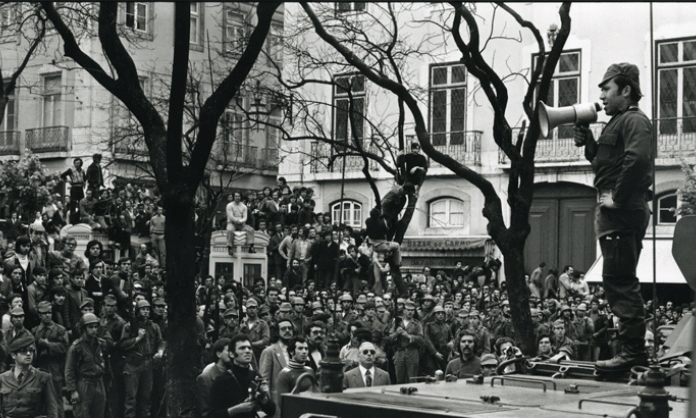The revolution began at 25 minutes past midnight, with the popular tune Grandola Vila Morena, a song banned by the dictatorship: “Grandola, brown village in a land of brotherhood”. When the song played on radio, the Armed Forces Movement (MFA) – an underground organisation of military officers – moved on 25 April 1974 to end the quasi-fascist regime established by Antonio Salazar in the 1930s.
At first Portuguese were naturally sceptical of a military coup, but they soon realised that it had created a huge space for working class struggles and protest movements. Employees at the airline TAP had paved the way with strike action under the old regime. Workers at the Timex factory, mostly women, opened the way under the new regime, fighting for a pay rise and for the purging of fascists. They sold watches in the street to finance their strike.
Portugal was the least developed country in Western Europe. Attempts to build the economy with injections of capital had created social contradictions, with the working class growing substantially due to the boost from foreign funds, alongside a continuing small and backward local capitalist class. Thousands of workers learned the latest industrial techniques at the Lisnave and Setenave shipyards. They learned the most radical politics too.
At the same time, Lisbon was clinging to the last of the great colonial empires, in Africa and in Asia (including East Timor). It was fighting to keep this empire, and losing. This military fiasco was destabilising the armed forces, including officers who were sometimes mocked in the streets. After the coup, many such officers supported the left.
Even the majority of capitalists were dissatisfied with the state of things. Considerable power in the ruling class was concentrated in the hands of two private industrial empires. Protected by tariffs and regulations, the large conglomerate Companhia União Fabril and banker and industrialist António de Sommer Champalimaud dominated the scene, with little incentive to modernise.
A decision to allow token trade unions after 1965 had discredited official trade unions in workers’ eyes. Under such conditions, jobs were unattractive, and some workers headed for other parts of Europe. Portugal’s population actually fell in the late ’60s.
After 25 April, with a provisional government in place, few workers went on strike. The new president, General António de Spínola, aimed simply to “renovate” state power. But demands were rising to “introduce the revolution” into the workplaces. When the bosses resisted, the situation naturally led to strikes. On 15 May the 8,400 Lisnave shipyard workers occupied their workplace, demanding a pay rise. By May, 158 workforces were staging occupations, four of them holding managers captive.
In some places fascists and their collaborators were being purged (saneamento). Where management couldn’t or wouldn’t agree to such purges, it was a sign of just how strong their position was in society. Saneamento implicitly raised the question of who held political power in the workplaces. Meanwhile, the lack of union credibility led workers to experiment with other forms of organisation, ranging from the inter-enterprise network (interempresas) to the revolutionary councils promoted by the far left.
The MFA was the most powerful group in the country and was radicalising. Its members formed the 5,000-strong Continental Operations Command (COPCON), which was controlled by radical left wing officers and commanded by Otelo de Carvalho. In September 1974 the Lisnave shipyard organised an “illegal” strike. It was sharply criticised by the Communist Party and banned by the government. But the impact on COPCON troops was dramatic.
One rank and file soldier related, “After lunch a rumour circulated that we would be going out, and we guessed it was to Lisnave … The demonstration began and a human torrent advanced with shouts of ‘The soldiers are the sons of the workers!’
“The commander saw that we were not going to follow his orders, so he shut up … Before next day’s morning assembly many COPCON comrades were up and shouting the slogans of the demo: ‘The soldiers are the sons of the workers!’ and ‘Down with capitalist exploitation!’”
Workers in the saddle
The right was not pleased. General Spínola laid plans for a right wing mobilisation of 300,000 people. Enough fascists were handed guns to sow trouble at the margins. From 8pm on 27 September, the right mobilised. But the left was also prepared. They blockaded all the major roads into Lisbon. Railway workers stopped the trains, and bus drivers stopped the buses. It was a convincing example of working class power. Spínola’s demonstration of the “silent majority” never happened.
People sometimes ask me, what was it like to be in a city where, to paraphrase George Orwell, the working class was in the saddle? Well at first glance it was a bit like Brunswick or Newtown – there were posters everywhere! Most notable was the extent of public debate, which was astonishing.
If you dropped into the tourist information office, they gave you a complete list of left and revolutionary organisations in Lisbon, complete with name, address and phone numbers.
There were no police in the streets. Correction: I once saw two of them down a back alley. I suppose if someone nicked your stereo, you still reported it to the police. But the point is that the cops made no attempt to put their stamp on the social order.
Travelling by train from Lisbon to the seaside suburb of Estoril, we saw a notice in the ticket booth announcing that prices would be reduced so that working class people could afford to go to the beach.
Among the hundreds of companies being run under workers’ control, one found time to meet with us visiting revolutionaries and discuss their experience. I had the striking experience of chatting with insurgent Portuguese workers in their boardroom, and debating whether Russia was socialist or state capitalist.
In his important discussion of the revolution, Peter Robinson describes social changes in the countryside and the transformation of the traditional peasant women:
“Often illiterate, dressed in black from head to foot, they did much of the back-breaking labour. Now they not only ensured that they were paid regular wages, and at almost the same rate as men, but also played a part in the management of the cooperative.”
A golf course in the fashionable Algarve region declared it was now open to all – except the members.
The Portuguese far left had grown in the final years of the dictatorship. Of the revolutionary groups, the most promising was the Revolutionary Party of the Proletariat (PRP), which built a strong relationship with the leftward moving soldiers and even officers – right up to Otelo de Carvalho. Confronting them in many political arguments were the Communist Party with its top down methods and later the Socialist Party (comparable to our ALP), which grew as the Communists disappointed their supporters.
When the Communist Party restrained those who wanted to fight, some militants turned to the far left. Others turned to the Socialist Party, which made militant noises. It had few actual responsibilities in the early days, but won a resounding victory in the April 1975 elections for a constitutional assembly.
Attempted coup
Despite the elections, the left was holding its ground in Lisbon and the south. Frustrated right wingers led by Spínola sent supposedly reliable troops against the left. But after discussion, these troops declared, “We are no fascists; we are your comrades.” Spínola was forced to flee the country while industrial action stopped the coup makers for a few months.
But they soon revived. Nine senior officers issued a document calling for restraint and acceptance of decisions of the constitutional assembly. In response, COPCON published a manifesto calling for the revolution to transcend this kind of ordinary capitalist democracy.
The far left and rank and file shop stewards from industry called for a demonstration in support of COPCON. The Communist Party opposed such a demo as too extreme. But sentiment among the militants was too strong – the Communist Party was ultimately forced to back the march. Thus the scene was set for a confrontation as we arrived in Lisbon in early August.
Having backed the march, the Communist Party had access to the organising committee, where it began arguing to moderate its politics. On the day of the demonstration, a tug-of-war took place between different contingents about the slogans. We were part of a far left contingent chanting “Revolutionary United Front”, whilst the marchers next to us were yelling “People’s United Front” – a slogan more moderate in tone. Soldiers and sailors led the march, but they were a small detachment and not armed.
Still, it was a mass militant action that pulled the Lisbon political scene to the left. The potential still existed to take the revolution forward. But the Communist Party continued its unfortunate work. A follow-up march that should have meant another step leftwards became a way to bury the movement.
The march was carefully designed to take the edge off things. Where the original demonstration marched through the centre of town, this one marched away from the centre. Where the first march was full of red banners, this one featured coloured balloons. Where the first demo had revolutionary speakers, the second had conventional politicians. We were offered no revolutionary slogans to chant.
That week in August was the last great high point of the revolution, and due to the Communist Party, it drowned in ambiguity.
The right wing sensed its opportunity. On 24 November, Otelo de Carvalho was removed from his command positions. Younger officers begged him to defy the order. He refused. The lack of a coherent, sizeable revolutionary party now became evident. There was resistance all over Lisbon, but it was fragmentary and directionless. The revolution began to dissipate.
Ultimately the big winner was the Socialist Party. Its leader Mario Suares became Prime Minister in the first regular elections. A vast social upheaval that opened up some possibilities for socialism subsided into a democratic election within capitalism.
[Some factual detail and a range of quotations in this article are drawn from the excellent book Revolutionary Rehearsals. The successor book will be published in 2015 by Bookmarks.]











